ISSN ONLINE(2278-8875) PRINT (2320-3765)
ISSN ONLINE(2278-8875) PRINT (2320-3765)
Shilpi Soni1, Raj Kumar Sahu2
|
| Related article at Pubmed, Scholar Google |
Visit for more related articles at International Journal of Advanced Research in Electrical, Electronics and Instrumentation Engineering
In this paper a new technique Directional 2DPCA is developed. Face image was firstly rotated to several directional, the directional 2DPCA that can extract features from the matrixes in any direction. In 2DPCA reflects the information in each row but it cannot be uncovered the structural information so in this paper features can extract in any direction. Features were extracted from original face image and it is rotated in six different directions. Then we combine a bank of Directional 2DPCA performed in different directions to develop multidirectional 2DPCA.The results of experiments on ORL datasets show that the proposed method is more effective and achieves higher recognition rate than traditional PCA method.
Keywords |
| PCA, 2DPCA, D2DPCA, MD2DPCA, Euclidean distance |
INTRODUCTION |
| In the last years, Face Recognition as the most successful applications of image analysis and computer vision. Face recognition has become one of the most important biometrics authentication technologies in the past few years. Biometrics is widely adopted in various applications areas such as access control, remote login, border control, etc, since it provides unique identification. Biometrics is used for privacy and security concern arises. Recognition implies the tasks of identification or authentication. Identification involves a one-to-many comparison. Authentication involves a one-to-one comparison. In a face recognition system, 3 steps includes: Face detection, feature extraction & face recognition. |
 |
| Feature Extraction Methods involved two based method are vector based and matrix based methods. In the vector based methods the 2D facial image matrix must be transformed into 1D vector. PCA and LDA are two well known vector based methods for feature extraction. This method is very time consuming as well as include a large scale scatter matrix. In matrix based methods directly deals with matrixes do not need the matrix to vector coversion.2DPCA is matrix based method which work on image matrices for feature extraction. |
| 2DPCA was proposed by Yang et al [2]. 2DPCA has the lower dimensionality than that of PCA. 2DPCA is more efficient than PCA.2DPCA directly extract the feature from the matrix by projecting the image matrix along the projection axes that are the eigen vectors of the image scatter matrix. Directional 2DPCA (D2DPCA) was proposed by Qi Zhu et al [3], the D2DPCA can extract features from the matrixes in any direction where as 2DPCA reflects the information in each row and some structure information cannot be uncovered by it.2DPCA is row based PCA method. |
| In this paper we are adopting face recognition technique by D2DPCA technique. This paper is organized as follows: Section I was a brief introduction of this paper. Section II is giving an overview of face recognition related works performed by before this work. Section III is describing Methodology. Section IV is the experimental results section where results obtained from D2DPCA and finally Section V is the conclusion of this work.website. |
RELATED WORK AND BACKGROUND |
| A Principal component analysis is most popular dimensionality reduced technique used for calculating eigen features. Turk et. al. [4] developed eigen face techniques for face recognition. Using eigen vector and eigen values project the eigen faces represent primary components of the faces. Weights are used to represent the eigenface features so a comparison of these weights permits identification of individual faces from a database. Baek et. al. [5] used PCA and ICA over FERET face database and found that when a proper distance metric is used, PCA significantly outperforms ICA on a human face recognition task. Moghaddam et. al. [6] used the Eigenface Method on human faces for applications such as video telephony, database image compression and face recognition. Two dimensional principal component analysis (2DPCA) [7] has been proposed and been widely applied in face recognition. Different from the classical PCA, 2DPCA takes a 2D-matrix-based representation model rather than simply the 1D-vector-based one. And image covariance matrix is constructed directly from the 2D image matrices. Since the size of image covariance matrix is much smaller, 2DPCA can evaluate the matrix accurately and computational more efficiently than PCA.2DPCA also gives higher face recognition rate than PCA. Xu et al. [8] analyze the theoretical similarities and difference between 2DPCA and PCA. A drawback of 2DPCA is that it needs more coefficients than PCA, 2DPCA needs more memory to store its features and more time in classification |
| To overcome these problems, Zhou et al. [9, 10] proposed the bidirectional PCA(BDPCA) and Zhang and Zhou [11] proposed the 2directional2dimensional PCA ((2D)2PCA). BDPCA and (2D)2PCA can do image feature extraction by reducing the dimension in both column and row directions. Zhang et al. [11] proposed diagonal principal component analysis (DiaPCA). DiaPCA keeps correlations between variations of rows and column by seeking the optimal projective vectors from the so called diagonal face images which are used to extract further information in diagonal direction. Directional 2DPCA (D2DPCA) was proposed by Qi Zhu et al [3], the D2DPCA can extract features from the matrixes in any direction where as 2DPCA reflects the information in each row and some structure information cannot be uncovered by it.2DPCA is row based PCA method. Xiao HU et al [12] proposed multi-oriented 2DPCA for face recognition in these method , one face image was firstly rotated θ degrees using bilinear interpolation to gain several face images with different directions then features were extracted from origin face image and its rotated face images for each face image. |
METHODOLOGY |
| The Eigenface method tries to find a lower dimensional space for the representation of the face images by eliminating the variance due to non-face images; that is, it tries to focus on the variation just coming out of the variation between the face images. Eigenface method is the implementation of Principal Component Analysis (PCA) over images. Fig. 2 shows the flow chart of Multidrectional 2 dimensional PCA Algorithm. In this method, the process of PCA each block is explained by mathematical expression and calculation in below. The features of the rotated images are obtained by looking for the maximum deviation of each image from the mean image. This variance is obtained by getting the eigenvectors of the covariance matrix of all the images [5]. The eigenface space is obtained by applying the eigenface method to the training images, rotated in six different directions. Later, the training images are projected into the eigenface space. Test image is also projected into this new space and the distance of the projected test image to the training images is used to classify the test image [12] |
| Mathematical Expression for Feature Extraction By using Directional 2DPCA |
| In this paper, Principal Component Analysis with improved version i.e. Directional 2DPCA is used for feature extraction. Face image is taken as two dimensional matrixes and rotated. Rotated images are appended to form array. ORL face database is used for this face recognition process. Feature Extraction process is described as below |
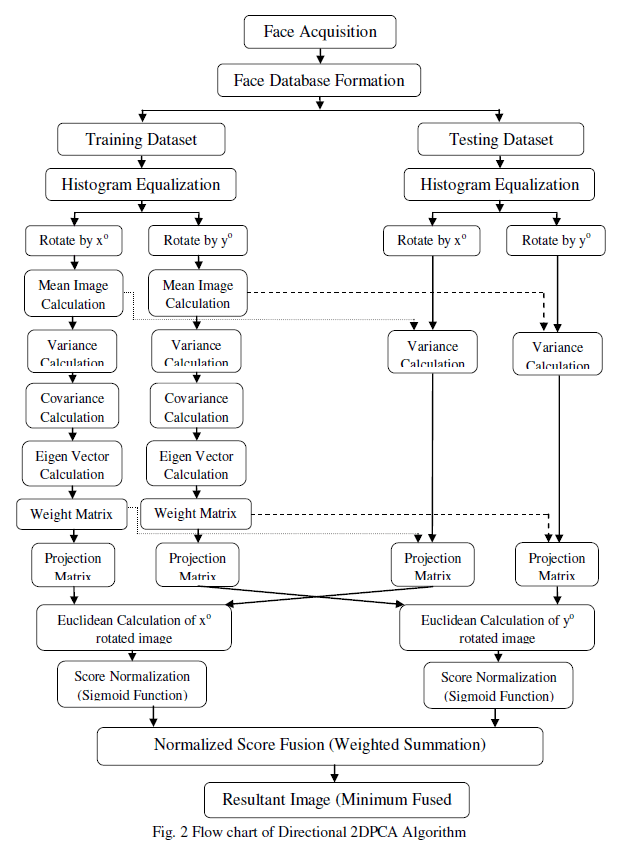 |
A. Training Phase |
| 1) Image |
| All 320 training facial images which are under training database are of size 92x112 pixels. These images are then cropped into 64x64 pixels. |
| 2) Image Rotation |
| Cropped images are then rotated and are page wise appended to form arrays. Here images are rotated by 10o, 20o, 30o, 40o, 50o. So there will be 6 arrays including array of 0o rotated images. |
| 3) Face Mean Calculation |
| Now mean of each array is calculated |
 |
| This 2D matrix is the arithmetic average of the training images at each pixel point and its size is also (64x64) pixels. |
| 4) Mean subtracted image |
| Then each of rotated training images is subtracted from its respective mean image. |
| Its size is (64x64). |
| 5) Variance Array Calculation |
| All of these mean subtracted rotated images, i.e. variance of each image, are appended to form an array represented by A. Its size is (64x64x320). |
| 6) Covariance Matrix |
| Covariance of each variance matrix is calculated which is product of variance matrix with its transpose. |
| Then covariance matrices of all facial images are added. Hence for each type of rotated face images, covariance matrix size will be (64x64). |
| 7) Eigen values & Eigen vectors calculation |
| Eigenvectors vi and eigenvalues μi of X are calculated as |
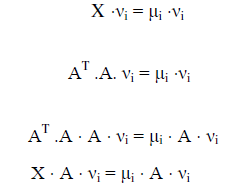 |
| The value of X is put in this equation, |
| The necessary matrix arrangements are made, |
| Now replace Α i with υi |
| Hence υi = Α ⋅ ��i is one of the eigen vector of X and its size is same as X i.e (64x64). |
| Also there will be 64 numbers of eigen values and it will be in the form of (64x64) diagonal matrix. |
| Eigen vectors corresponding to highest eigen values are selected. |
| 8) Eigenface Matrix calculation |
| It is product of variance of each face image with d numbers of highest eigen vectors. |
| It will be of size (64x40x320).If we are taking 40 highest eigen values. |
| 9) Projected train matrix calculation |
| where i= 1, 2, 3……320 |
| And on selecting and appending only projected training matrix will be of size (40x64x320). |
B. Testing Phase: |
| 1) Test image- |
| Facial images which are under test are also of size 92x112 pixels. This image is then cropped into 64x64 pixels. |
| 2) Image Rotation- |
| Cropped images are then rotated. Here also images are rotated by 10°, 20°, 30°, 40°, 50°. |
| 3) Mean subtracted image- |
| The cropped and rotated test face image, t is subtracted from mean image of database, |
| Its Size will be (64x64). |
| 4) Projection test matrix calculation |
| Projected Test image of each of rotated image is then calculated from their respective eigen face matrix. |
| It will be of size (40x64). |
| C. Classification |
| Each of the rotated test images is then classified with their respective training images by calculating the distance or similarity measures between the respective projected train matrices and projected test matrix. Euclidean Distance is used to calculate the distance. It is given by |
 |
| D. Normalization |
| Distance Score between each of rotated projected training image and projected test image is then normalized. By normalization, distance scores of each of rotated face image are mapped between 0 and 1. Sigmoid function is used for normalization in this technique. |
 |
| E. Fusion |
| Feature level fusion refers to combining different feature vectors. Here fusion is being performed by weighted summation method, which is feature level fusion of pre-classification type fusion. |
| It is given by |
| where values of weights are selected such that, w1 + w2 =1. |
| F. Recognition |
| At this stage, test image is recognized with training image. To carry out this task, simply minimum value of fused score s is found. |
| Output = min ( dk) |
| Its location reflects the facial image under test. |
EXPERIMENTAL RESULTS |
| In this paper, Olivetti and Oracle Research Laboratory (ORL) face database base is used. The database contains 400 images, 40 persons with 10 images each. Out of 10, 8 face images of each person are taken for training and 2 images are taken for testing. Test images, Rotated images and final output images by Directional 2DPCA are shown in fig 3, fig. 4 & fig. 5. On the basis of results, Table I is drawn, comparing results face recognition by 1DPCA and Directional 2DPCA. And Table II is comparison of recognition rates by varying eigen values. |
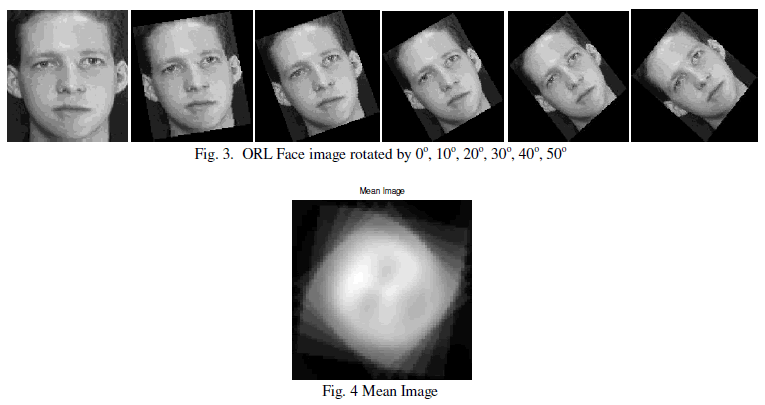 |
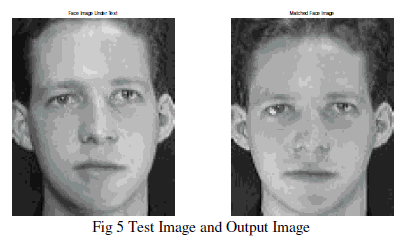 |
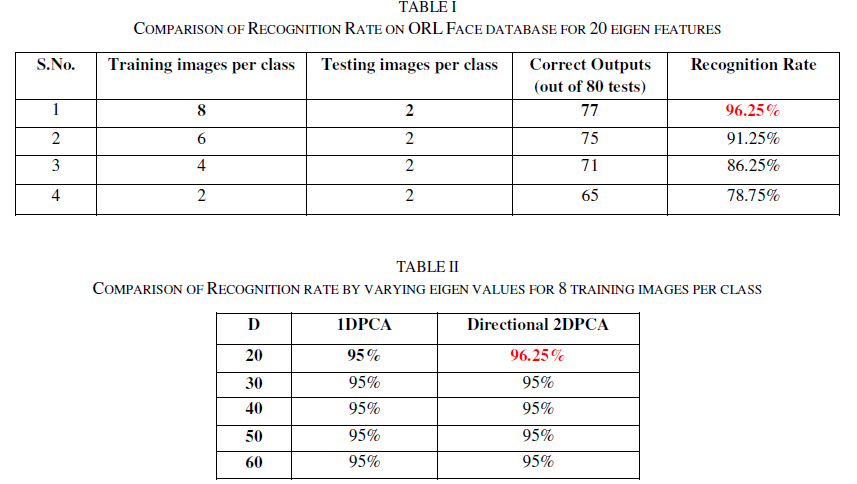 |
CONCLUSIONS |
| The paper presents a face recognition approach using Multidirectional 2DPCA and Traditional PCA. ORL face database has been used for facial images. The result is compared by varying number of training images per class and by varying number of eigen features. It is found that as number of training images increased recognition rate increases. For 8 training images per class of this database recognition rate is 96.25%, but the same is 78.75% for 2 numbers of training images per class. Moreover Multidirectional 2-Dimensional PCA is giving best result for 30% of eigen features only i.e 96.25% which is around 1.25% greater than the others when number of eigen features are increasing. |
References |
|